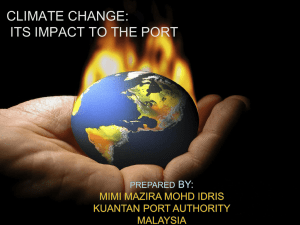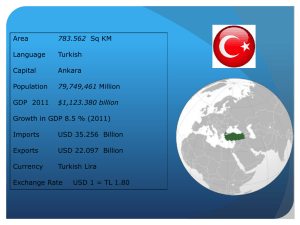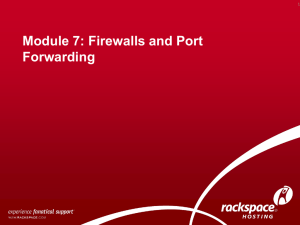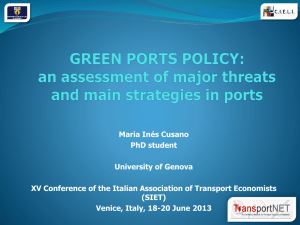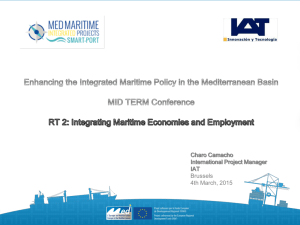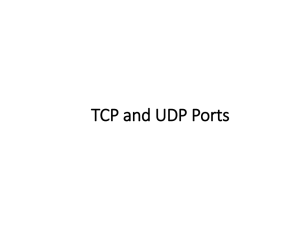Ports Australia - Shipping Australia
advertisement
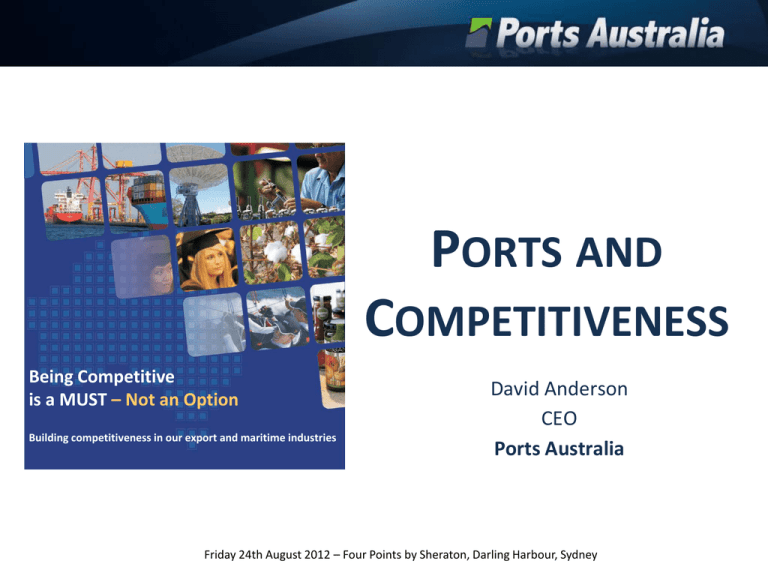
PORTS AND COMPETITIVENESS Being Competitive is a MUST – Not an Option Building competitiveness in our export and maritime industries David Anderson CEO Ports Australia Friday 24th August 2012 – Four Points by Sheraton, Darling Harbour, Sydney The National Ports Strategy constitutes major national reform and is the foundation stone of the National Freight Strategy. Adequate landside access to port and the provision of channel capacity commensurate with the freight task are essential to the efficient operation of the whole economy – if they do not function properly it is immaterial whether the rest of the freight network is operating efficiently. Ports Australia Submission to Infrastructure Australia (June 2010) PORTS AUSTRALIA IN BRIEF Branded as Ports Australia in 2007 • long history (1916) under various guises. Typical business model for a peak industry body • represent both private and publicly owned ports, and regulatory agencies • company with Board of port corporation CEOs Core business • advocacy (primarily on national stage) • advice to members on statutory and regulatory developments • sharing of information and best practice (9 working groups with strong member participation: Port Operations, Environment & Planning, Port Security, Accounting & Finance, IT, IR/HR, Work, Health & Safety, Engineers, Logistics High level of agreement about what is important Not an Industrial organisation Board of Ports Australia Gary Webb CEO, Newcastle Port Corporation Chairman Vincent Tremaine CEO, Flinders Ports South Australia Deputy Chair Chris Leatt-Hayter CEO, Fremantle Ports Deputy Chair Steve Lewis CEO, Dampier Port Authority Member Terry O’Connor CEO, Darwin Port Corporation Member Brad Fish CEO, North Queensland Bulk Ports Member Russell Smith CEO, Port of Brisbane Pty Ltd Member Stephen Bradford CEO, Port of Melbourne Corporation Member Jim Cooper CEO, Port of Portland Pty Ltd Member Grant Gilfillan CEO, Sydney Ports Corporation Member Paul Weedon CEO, Tasmanian Ports Corporation Member • Total 70 Ports, of which 65 Regional • Main 16 Regional Ports handle 85% of Task • Main 20 Ports handle 95% of Task An Historical Perspective “That Port Authorities within the Commonwealth be recommended to keep each other informed from time to time ....” “ .... The Statutes relating to Harbors and Harbor Authorities where they have becoming cumbersome owing to amendments be consolidated by the Legislature of such State” “ ..... should present the Resolutions to the next Conference of State Premiers with a view to securing such Parliamentary measures or other necessary action in the States as may be required to facilitate uniformity of action by Port Authorities ......And ..... the Conference of State Premiers be urged to make representations to the Commonwealth Government in order to secure the objects of the Resolutions” First Inter-State Harbor Conference – Melbourne, November 1916 Extract From Resolutions Threats to Port Competitiveness – The Short Story • Community (also read political) attitudes to freight facilitation • Incapacity to plan for robust trade growth • Supply Chain Disconnects • Regulatory Risk • Productivity and Landside Costs • Governance Models • Sourcing the skilled people Start With A Conversation About Freight A greater preparedness on the part of governments to promote public awareness of the importance of freight is, in our view, a threshold issue. Governments readily engage with their constituencies on standards of living and the price of consumables but stop short of drawing a nexus between these issues, and the performance of the freight transport sector, and port development and efficiency in particular. Ports Australia Submission to Infrastructure Australia, October 2008 • Freight is a big deal Minister • Governments getting better at fostering this discussion • still quick to revert to political imperatives • locating political champions and embedding freight management as an all-of-government/all-of-agency approach is a necessity Enter the National Ports Strategy (NPS) - Drivers • Trade Growth (having capacity as well as competitiveness) • Planning Failures and Land Use Conflicts • urban encroachment • Maximising Benefits of Portside Investment • landside capacity • ports and supply chains • Facilitating timely and predictable expansion in capacity • appropriate regulatory and approvals regimes • Co-existence of Cities/Communities and Freight • functional ports and functional communities ("liveability") • Languishing National Productivity Forecast Trade Growth Container Trades • 5%-7.5% cag; port throughput to increase 3 to 6 times in 25 years • 7.5% cag; container task will double by 2030 Bulk Trades • Iron ore, 5% cag; 350mt 2008/09 to 800mt 2030 10% growth; 2100mt by 2030 • Coal, 5% cag; 260mt 2008/09 to 700mt 2030 7.5% growth; 1200mt by 2030 • LNG to become leading export by value Reflecting on forecasting and global risks - Source: Sydney Ports actual Low Growth Likely Growth Strong Growth FY 39/40 FY 38/39 8,000,000 FY 37/38 14,000,000 FY 36/37 16,000,000 FY 35/36 FY 34/35 FY 33/34 FY 32/33 FY 31/32 FY 30/31 FY 29/30 FY 28/29 FY 27/28 FY 26/27 FY 25/26 FY 24/25 FY 23/24 FY 22/23 FY 21/22 FY 20/21 FY 19/20 FY 18/19 FY 17/18 FY 16/17 FY 15/16 FY 14/15 FY 13/14 FY 12/13 FY 11/12 FY 10/11 18,000,000 FY 09/10 FY 08/09 FY 07/08 FY 06/07 FY 05/06 FY 04/05 FY 03/04 FY 02/03 FY 01/02 FY 00/01 FY 99/00 FY 98/99 FY 97/98 FY 96/97 FY 95/96 Sydney’s Growth Projections – 30 Year Total Container Trade 15,542,982 13,557,706 12,000,000 10,000,000 7,848,787 6,000,000 4,000,000 2,000,000 Port Hedland Port Growth Projections Source: Port Hedland Port Authority Dampier Port Authority - Module Movements 435 modules bought through Dampier to date – a now wellestablished construction method for LNG plants. Source: Dampier Port Authority Planning Failures and Land Use Conflicts Residential Apartments 2.5 – 25m from rail freight line. Rail Freight Line Rail Freight Line – Little High Street, Fremantle Urban Encroachment on Primary Road Freight Route Proposed 5 level residential development 4 meters from road Road freight route Walter Place & Curtin Avenue, North Fremantle The Ports Master Planning Process • Long term integrated master plans for ports guided by best practice • Facilitation by range of support mechanisms • expert panel and proactive agency support • BITRE • BREE • Recognition and ownership of port plans by • governments • supply chain stakeholders • communities Supply Chains – Things Never Change but Everything is Different "... almost eight years after the extravagances and inefficiencies of the transport chain from the warehouse to the wharf began to be exposed little has been done to remove them". (ISC, Webber Report) "Participants along the chain have each operated within their own discrete worlds without regard to the impact of their actions on the overall efficiency of the chain. "While improved efficiency, reliability and lower transport costs may not be a priority for individual firms, taken collectively, they are major issues in helping Australia become more competitive in domestic and international markets" (Warehouse to Wharf, HoR Standing Committee, April 1992) Supply Chain Coordination and Efficiency Measures • Some good models now available • Hunter Valley Coal • MITEZ • PBLIS • Exploring technologies • opportunities for smart technology applications to freight management • inspiring collaboration • Provision and management of access infrastructure • including pricing Regulatory Risks • Reputation as low risk country being degraded • $100 billion in gas projects at risk because it costs three times as much to develop them here than in the Gulf of Mexico and twice as much as elsewhere (David Knox, AFR, 23/08) • Over-regulation including in • environmental clearances and approvals (including dredging) • maritime security • labour • Cost shifting from government to industry • eg security, EBPC cost recovery • COAG is talking the talk but not manifested in agency behaviour • some agency cultures disconnected from macro-economic policies • however some resolve apparent to reduce jurisdictional duplication (COAG says process is "broken") National Ports Strategy seeks: • streamlined environmental regime and strategic assessment process • speed and predictability Productivity and Landside Costs • Background work for NPS indicated landside costs very high comparative to total transport costs • Example: all the real growth in reported interface costs over last 13 years at five container ports is attributable to landside costs (BITRE) • reflects a number of factors including truck and rail utilisation, congestion, and infrastructure management issues • Port productivity – first tier issue is accurate measurement • NPS envisages improvements in measurement and benchmarking • At national level productivity is languishing • annual decline of 0.7 % in Australia's productivity between 2005 and 2011; 2.4% 1993 to 1999 • figures show decline in both capital and labour productivity NATIONAL PRODUCTIVITY • Strong Growth in the 1990s (2.3% p.a.) • Declining Growth since 2003-04 (-0.4% to 2008-09) National Productivity Productivity growth has slowed in most OECD countries (Source: Grattan Institute) • Strong Growth in the 1990s (2.3% p.a.) • Turning negative over past five years Productivity – Labour Productivity Should Be Part of the Conversation Federal Government constantly refers to the need for productive economy • but has excised labour productivity from the discussion • couches productivity in context of "education revolution", skills development and infrastructure spend • employers apparently not being sufficiently innovative and flexible (the ultimate irony), and in some instances tagged with Work Choices bogey. Comparison of International Stevedoring Salaries (Real 2012 AUD) Country 2012 Annual Remuneration at Current Exchange Rates 2012 Annual Remuneration at 2005 Exchange Rates United Kingdom 37,929 61,450 United States of America 62,574 88,552 New Zealand 71,886 84,065 Approx. 100,000 Approx. 100,000 Australia Sources: UK Office for National Statistics, Salary.com, Ernst & Young, SupplyChainReview.com.au, www.oanda.com Notes: Numbers represent the full stevedoring remuneration package. UK salary is for 2011 and is inflated at the average of the previous two years’ increases, Australian salary is 2011 but is not inflated as it was only given as a bro ACCC – Container Stevedoring Monitoring Report No. 13 (p. 30) Results of the ACCC's monitoring program shows that some measures of productivity – namely the elapsed labour rate and the ship rate on a container per hour and on a per TEU basis – have generally increased since 1998-99. This is likely to reflect more flexible labour arrangements over the last decade. However, the benefits of labour market reforms are likely to have been exhausted several years ago. Current enterprise wage negotiations between the Maritime Union of Australia (MUA) and each of the stevedoring companies are significant as they set the terms at which higher wages outcomes will be offset against labour-based productivity gains over the next three years. October 2011 Fair Work Act – General Observations • Its the regime we did not need to have Limits ability of a port authority to manage its business • new and complex provisions with effect of regulating the employer • removal of credible non-union stream for agreement making • allows enterprise agreements to regulate relationship between employer and union (union standards not modern award standards) Long, drawn out, costly EBA negotiations • protected strike action for indefinite periods • Asciano has been negotiating 18 months Governance • Improvement of governance models for publicly owned ports a major issue • in the first instance its about settings provided by government shareholders • does not need to involve a debate about ownership • Behave as privately owned organisations (clarity of roles and responsibilities) • strategic economic managers (off port investments and freight priority) • act in a transparent and even handed manner • jurisdictional review of legislation • clarity of function • Boards • leadership role • master planning • best practice principles • Shareholder governments will have different views • but there are some base line imperatives Skilled People in Demand • Tightness in labour market in some particular sectors impacts on competitiveness • wage costs and boom cultures • causes capacity constraints • distorts labour market • structural rigidities • Labour immobility part of the problem • how sustainable overseas recruitment? • No silver bullet • companies with innovative retention strategies have market edge (value propositions not total panacea) danderson@portsaustralia.com.au Ports Australia 43rd Biennial Conference Adelaide, 24 and 25 October 2012
